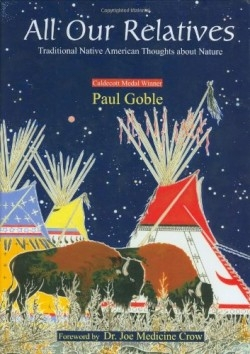All Our Relatives
Traditional Native American Thoughts about Nature
One hot day, famous Indian leader Sitting Bull was resting with his eyes closed in the shade by the river when a woodpecker warned him, “Lie still!” He discovered a huge grizzly bear standing over him, but obeyed the bird, and the bear left. After that, it is said, he always paid close attention to what birds told him.
This is one of twenty-three traditional tales collected by the author reflecting the Native American belief of the interrelationship and interdependency of all living things. Several stories seem to parallel the probably more familiar Aesop’s fables. Following each brief story is a series of quotes taken from the writings of those who lived the nomadic life on the Great Plains, long-ago voices from various tribes such as Blackfoot, Arapaho, Kiowa, Cheyenne, and Pawnee.
Goble, who was born in England but has lived in the United States for nearly thirty years (he became a citizen in 1984), is an award-winning children’s author and illustrator. He received the Caldecott Medal in 1978 for The Girl Who Loved Wild Horses. Most of his twenty-eight published books reflect his life-long fascination with the Plains Indians and their way of life.
This book’s title is taken from the Lakota phrase “mitakuye oyasin,” which translates to “all my relatives” and is often used in tribal ceremonies and prayers. The text is decorated with Goble’s artwork portraying bird and animal designs, copied from tepees, shields, and drums and considered sacred “because they picture … that which came in dreams to give their protection, encouragement, or direction for people’s lives.”
For example, there’s the over-zealous hunter who hunted when he didn’t even need the meat. He learns his lesson when the elk he’s tracking knock him down and he’s scolded by the protector of the elk family. To make amends, he must paint his lodge with the elk symbol on his return to camp.
All aspects of nature—large and small—are depicted and represented here. One bit of Arapaho wisdom recalls how the turtle became a symbol of earth: “The ridge on her back is the mountain-line, and the marks are streams and rivers. She herself is like a bit of land in the midst of water.”
Though designated as a book for older children, it probably is more appropriate for older readers, and even adults, who may appreciate and respect the content even more. As Lame Deer, a Lakota, wrote: “You have to listen to all these creatures, listen with your mind. They have secrets to tell.”
Reviewed by
Robin Farrell Edmunds
Disclosure: This article is not an endorsement, but a review. The publisher of this book provided free copies of the book to have their book reviewed by a professional reviewer. No fee was paid by the publisher for this review. Foreword Reviews only recommends books that we love. Foreword Magazine, Inc. is disclosing this in accordance with the Federal Trade Commission’s 16 CFR, Part 255.

